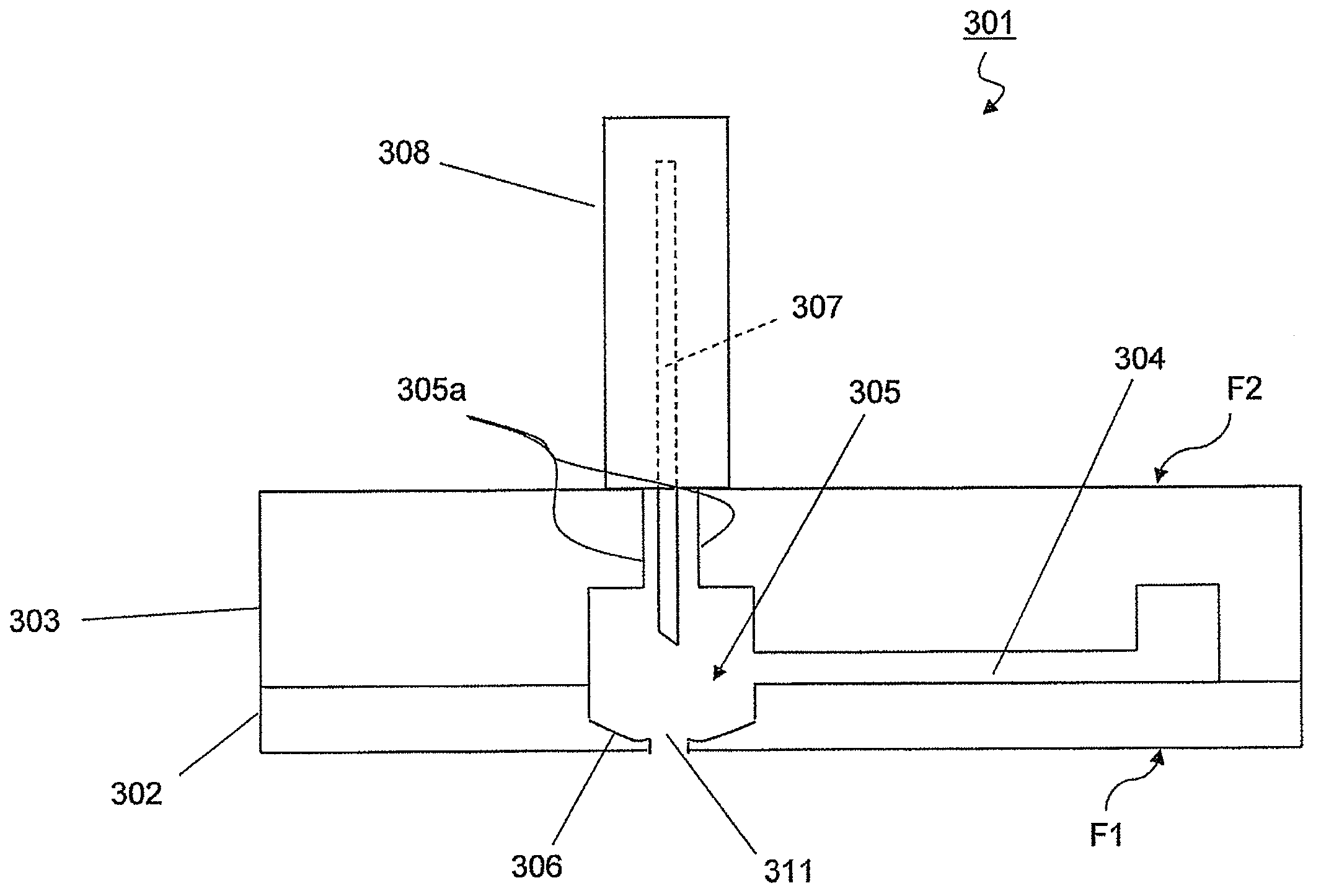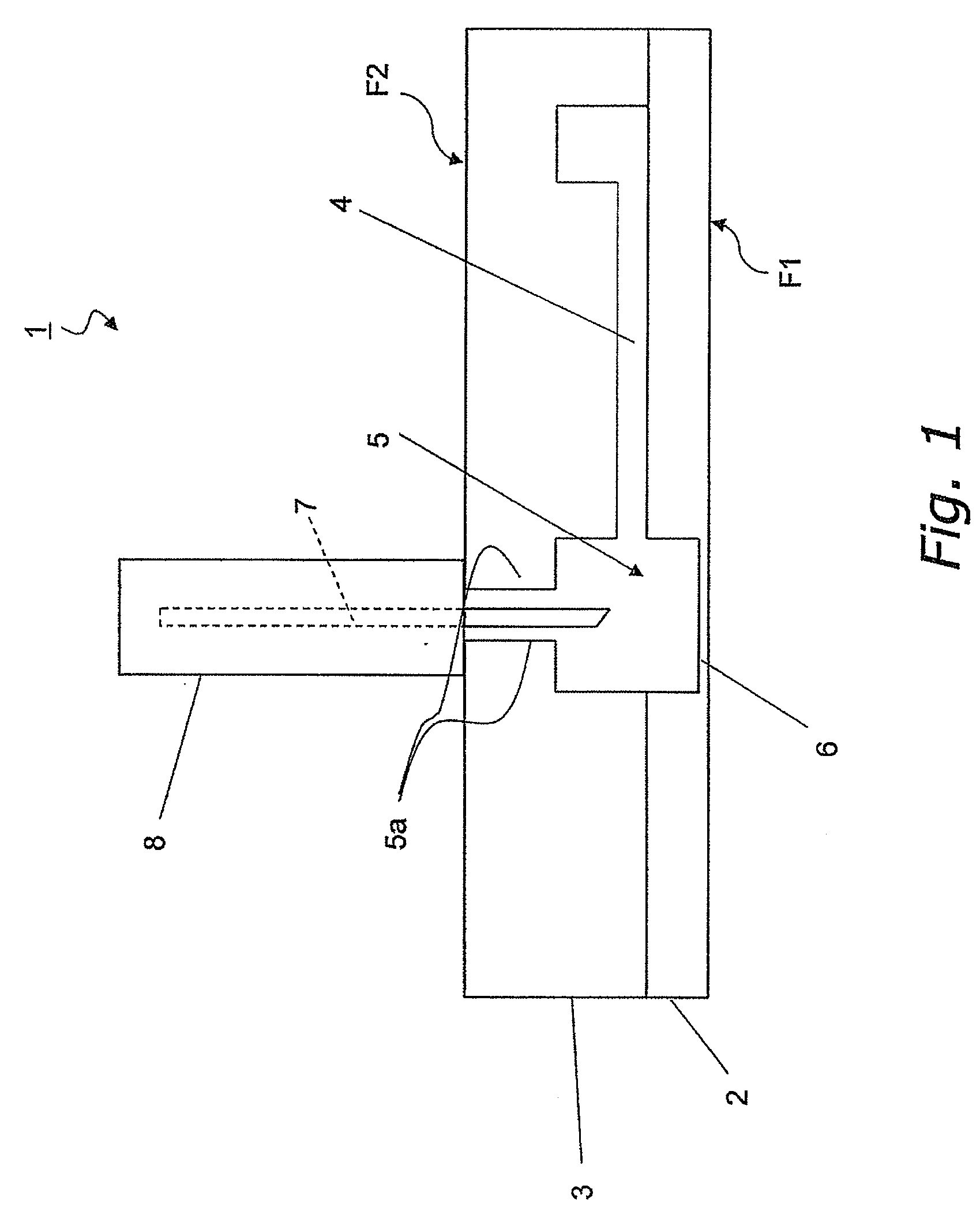Analyte collection chip
a technology of analyte and chip, which is applied in the field of biochips, can solve the problems of difficult needle inserting into the vein, inability to collect blood without an environment, and high cost of carrying out tests, and achieve the effect of convenient collection of analyte from a living body and efficient introduction of blood
- Summary
- Abstract
- Description
- Claims
- Application Information
AI Technical Summary
Benefits of technology
Problems solved by technology
Method used
Image
Examples
first embodiment
(1) Structure
[0031]FIG. 1 is a structural diagram of a chip according to a first embodiment of the present invention. As shown in FIG. 1, a chip 1 is formed by for example bonding together two thin plate shaped substrates 2 and 3. Here, in the chip, the contact surface with the living body is called the first surface F1, and the surface opposite to the first surface F1 is called the second surface F2. The material of the substrates 2 and 3 may be for example the organic compounds indicated below, or inorganic compounds such as glass, silicon, or metal. The organic compounds can include polyethylene terephthalate (PET), polydimethylsiloxane (PDMS), polymethyl methacrylate (PMMA), polycarbonate (PC), polypropylene (PP), polystyrene (PS), poly vinyl chloride (PVC), polysiloxane, allyl ester resin, cycloolefin polymer, ST rubber, and so on.
[0032]The chip 1 has an analyte inlet portion 5, which is an internally formed space, into which analyte is introduced. The chip 1 has a thin portion...
second embodiment
[0044]FIG. 4 is a structural diagram of a chip 101 according to a second embodiment. The chip 101 is formed by bonding together thin plate-shaped substrates 102 and 103. In the chip 101, the contact surface with the living body is called the first surface F1, and the surface opposite to the first surface F1 is called the second surface F2. The chip 101 includes an analyte inlet portion 105, and a thin portion 106. The analyte inlet portion 105 is a space formed within the substrates 102 and 103 into which analyte is introduced. The thin portion 106 is formed on the first surface F1 side of the chip 101, and partitions the space forming the analyte inlet portion 105 from the external space. Also, the thin portion 106 includes a film 109. The film 109 is formed on a part of the substrate 102 that is formed thinner than other parts. The film 109 is provided to ensure greater adhesion between the first surface F1 of the chip 1 and the skin of the living body. The film 109 is disposed in...
third embodiment
(1) Constitution
[0052]FIG. 5 is a structural diagram of a chip 201 according to a third embodiment. The chip 201 is formed by bonding together thin plate-shaped substrates 202 and 203. In the chip 201, the contact surface with the living body is called the first surface F1, and the surface opposite to the first surface F1 is called the second surface F2. The chip 201 includes an analyte inlet portion 205 and a film 209. The analyte inlet portion 205 is a space formed within the substrates 202 and 203, into which analyte is introduced. Also, an aperture 210 is formed in the first surface F1 of the chip 201 through which the analyte inlet portion 205 is exposed. The aperture 210 is formed in at least apart of the first surface F1 that contacts the living body.
[0053]The film 209 is formed to cover the aperture 210. The film 209 is provided to ensure greater adhesion between the first surface F1 of the chip 201 and skin of the living body. The thickness of the film 209 may be a thicknes...
PUM
 Login to View More
Login to View More Abstract
Description
Claims
Application Information
 Login to View More
Login to View More - R&D
- Intellectual Property
- Life Sciences
- Materials
- Tech Scout
- Unparalleled Data Quality
- Higher Quality Content
- 60% Fewer Hallucinations
Browse by: Latest US Patents, China's latest patents, Technical Efficacy Thesaurus, Application Domain, Technology Topic, Popular Technical Reports.
© 2025 PatSnap. All rights reserved.Legal|Privacy policy|Modern Slavery Act Transparency Statement|Sitemap|About US| Contact US: help@patsnap.com



